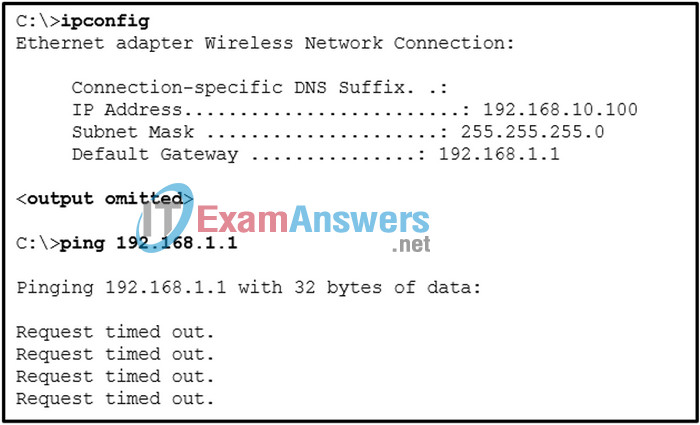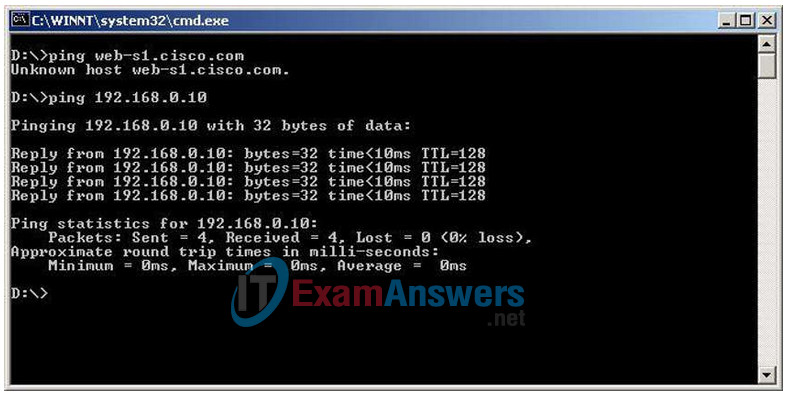20.7.3 Module 20 – Troubleshoot Common Network Problems Quiz Answers
1. The home computer of a user is working properly. However, the user cannot access the Internet. The Internet connection is provided through a cable company. The user cannot identify the cause of the problem. Who should the user contact for further help?
- the help line of the cable company
- the help line of the computer manufacturer
- the support web site of the computer vendor
- the operating system vendor
2. A network technician enters the command ipconfig /release followed by ipconfig /renew in order to ensure that the DHCP IP configuration on a workstation is updated. However, the workstation does not receive a valid IP configuration for the network. Which two problems may exist on the network? (Choose two.)
- There is no network connectivity to the DHCP server.
- The ipconfig /all command must be issued to restore all IP configurations.
- The DHCP lease time is misconfigured.
- There is a DHCP server issue.
- The gateway router address needs to be updated.
3. Refer to the exhibit. The command output is from a wireless DHCP host connected to a Linksys integrated router. What can be determined from the output?

- The connection to the SSID needs to be verified.
- A new wireless NIC needs to be installed.
- There is a DNS problem.
- The DHCP configuration needs to be checked.
- An incorrect cable is being used between the host and the router.
4. A customer called the cable company to report that the Internet connection is unstable. After trying several configuration changes, the technician decided to send the customer a new cable modem to try. What troubleshooting technique does this represent?
- bottom-up
- divide-and-conquer
- substitution
- top-down
5. A small office uses a wireless router to connect to a cable modem for internet access. The network administrator receives a call that one office computer cannot access external websites. The first troubleshooting step that the network administrator performs is to ping the wireless router from the office computer. Which troubleshooting technique does this represent?
- divide-and-conquer
- bottom-up
- top-down
- substitution
6. A network administrator can successfully ping the server at www.cisco.com, but cannot ping the company web server located at an ISP in another city. Which tool or command would help identify the specific router where the packet was lost or delayed?
- netstat
- traceroute
- telnet
- ipconfig
7. Which command would a technician use to display network connections on a host computer?
- nslookup
- netstat
- ipconfig
- tracert
8. Which three items should be documented after troubleshooting an internal web server crash? (Choose three.)
- the dialogue with the user
- when the problem occurred
- the configuration of all networking devices on the LAN at the time of the crash
- steps that were performed that failed to identify the cause of the problem
- the configuration of all hosts on the LAN at the time of the crash
- steps that were performed to identify the cause of the problem
9. A user calls the help desk to report a workstation problem. Which three questions would produce the most helpful information for troubleshooting? (Choose three.)
- If you received an error message, what was it?
- Do you have the warranty for your workstation?
- Have you performed a backup recently?
- What operating system version is running on your workstation?
- What changes have you made to your workstation?
- Have you used a network monitoring tool on your workstation?
10. What are two common causes of a physical layer network connectivity problem? (Choose two.)
- a faulty Ethernet cable
- an Ethernet cable plugged into a wrong port
- an incorrect default gateway
- a monitor unplugged
- an unassigned IP address
11. Refer to the exhibit. A web designer calls to report that the web server web-s1.cisco.com is not reachable through a web browser. The technician uses command line utilities to verify the problem and to begin the troubleshooting process. Which two things can be determined about the problem? (Choose two.)

- A router is down between the source host and the server web-s1.cisco.com.
- DNS cannot resolve the IP address for the server web-s1.cisco.com.
- The web server at 192.168.0.10 is reachable from the source host.
- There is a problem with the web server software on web-s1.cisco.com.
- The default gateway between the source host and the server at 192.168.0.10 is down.
12. Which step should be taken next once a problem is resolved during a troubleshooting process?
- Update the documentation.
- Escalate the problem.
- Run remote access software.
- Consult an FAQ.
